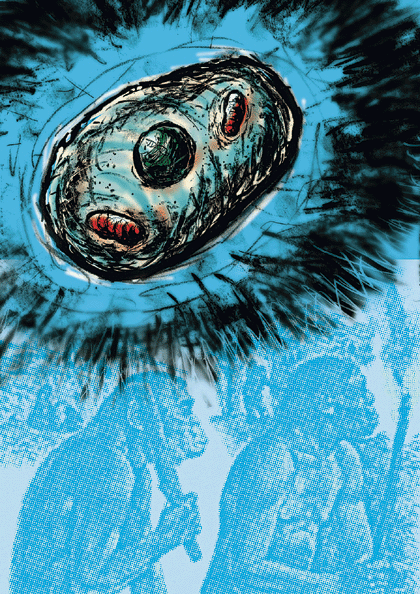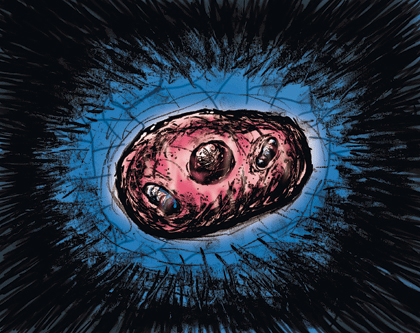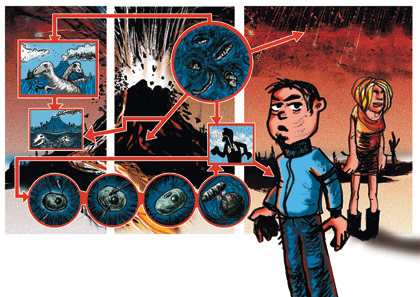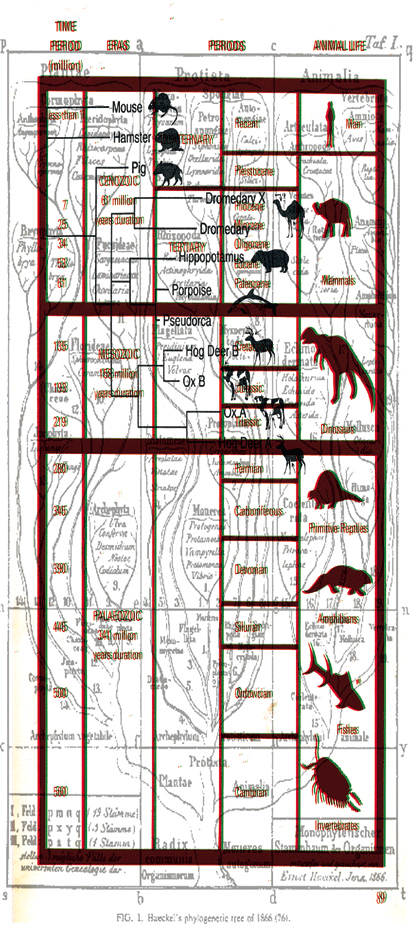Abstract Sex
Luciana Parisi shows how a parallel process of DNA transmission confounds Darwinian and neo-Darwinian conceptions of development. Can a new politics emerge from bacterial sex? Illustrations by Richard Starzecki
[...] we have seen [...] that it is most closely-allied forms, – varieties of the same species, and species of the same genus or of related genera, – which, from having nearly the same structure, constitution, and habits, generally come into the severest competition with each other; consequently each new variety or species, during the progress of its formation, will generally press hardest on its nearest kindred, and tend to exterminate them. We see the same process of extermination amongst our domesticated productions, through the selection of improved forms by man. Many curious instances could be given showing how quickly new breeds of cattle, sheep, and other animals, and varieties of flowers, take the place of older and inferior kinds. Charles Darwin, The Origin of Species
Whether it be in the development of the Earth, in the development of Life, upon its surface, the development of Society, of Government, of Manufactures, of Commerce, of Language, Literature, Science, Art, this same evolution of the simple into the complex, through a process of continuous differentiation, holds throughout. From the earliest traceable cosmical changes down to the latest results of civilisation, we shall find that the transformation of the homogeneous into the heterogeneous, is that in which Progress essentially consists...Herbert Spencer, ‘Progress: Its Law and Cause’

THE BACTERIAL ASSEMBLY
In 1981, Lynn Margulis’ research into bacterial mitochondrial transmission called into question the foundations of Darwinism and Neo-Darwinism. Margulis argued that mitochondria, organelles residing in the body of nucleated animal and plant cells, are in fact descendents of free-living bacteria. Enclosed in their mitochondrial membranes, these ancient bacteria have an independent genetic apparatus of their own, but were at some stage – possibly the moment in which oxygen entered the atmosphere 200 million years ago – captured within the cell body, though outside the nucleus.
Like all bacteria, these mitochondria reproduce, but their genetic transfer is non-linear and takes place only by way of the mother. However it got into the cell body originally, the presence of mitochondrial messenger material outside the nucleus constitutes a parallel process of transmission long unknown to science and unaccounted for within the Darwinian paradigm. It would seem that nucleic transmission is not the exclusive determinate of the evolution of the organism after all; indeed nucleic DNA itself is altered by the mitochondrial material that surrounds it. In other words, there are not one but two parallel and mutually infecting channels of genetic communication that determine the organism’s development. Indeed, within the same species, the nucleic germline and the bacterial somaline exhibit differential rates of mutation.
From these findings, Margulis has revolutionised the classical evolutionary understanding of the development of life, drawing on the work of Russian scholar-biologist Konstantin S. Mereschovsky who, in the first quarter of the 20th century, had already rejected the Darwinian theory of natural selection and invented the term ‘symbiogenesis’ to describe the prolonged symbiotic, parasitic associations that precede the appearance of a new organism. (Sapp, 1994; Sagan 1992, pp.362-85; Margulis, 1981, pp.1-14) A ‘guest’ bacteria, entering the cell, takes part in a transfer of DNA information with those ‘host’ bacteria already present. Bacteria move across phylums without regard, altering the genetic material of each lineage as they go.
Dismissed for a long time, symbiogenesis is acquiring a constitutive scientific importance, supported by molecular biology and biochemistry’s questioning of the classical division between plant and animal kingdom and the classifications based on this division. Symbiotic processes now in fact seem to explain the emergence of the cellular and genetic modifications of sex and reproduction, disrupting the the ‘zoocentrism’ of the theory of evolution (the priority of Homo Sapiens) in demonstrating that ‘each animal cell is, in fact, an uncanny assembly, the evolutionary merger of distinct bacterial metabolisms.’ (Sagan, 1992, p.363)
BIOTECH: THE OLDEST SCIENCE
In this sense, genetic engineering and cloning are not only not new, but not even particularly innovative complexifications of life. They strongly resemble the trading of genes invented by bacteria 3,900 million years ago: non-nucleated cells transmitting information without copulation. Perhaps all that is marked by ‘biotech’, the human recombination of genetic material between independent cellular bodies, is the re-emergence of the most ancient sex: bacterial sex.
But biotechnologies such as transgenics and cloning, insofar as they entail the horizontal transfer of genetic material, the re-engineering of cells across species barriers, do expose new levels of symbiotic mixture. For bacteria and endosymbiotic parasitism, they mark a new threshold, a new channel for a bacterial trading that will not constrict itself within the intentions of the scientists who opened it. Transgenesis accelerates differential mutations in patterns of evolution so that biotechnologies used, for example, to improve organs and cell transplants, make insulin, or produce new cells and tissues for ‘cell therapies’, are in fact promoting parallel, unknowable, non-filial recombinations of genetic sequences and cellular compounds that favour the emergence and re-emergence of new viruses – alongside new generations of mutant vegetables, insects, fishes, reptiles, sheep and humans. No longer species or individuals, forms or functions, transgenesis highlights evolution’s underlying pattern: packs of relations between bodies that engineer new bodies. It is simply not accurate to say that genetic engineering is technology’s colonisation of the biological: at the same time, the biological is abducting the transmission layer that biotech produces.
What is produced in this cross-colonisation of the biological and the technological layers of organisation, is a bio-digital assemblage, a symbiotic modification of matter that is not part of any natural ‘design’. The bio-digital assemblage of bodies – mouse and a micro-chip, a virus and a human organism – propagate the tendencies of symbiotic matter and accelerate the turbulent and unexpected swerves of non-linear DNA transmission. Micro-mutations within and across species are enabled and accelerated. The tendencies of the bio-digital assemblage of matter are non-linear; and the transactions between various chronological moments – the biological, the technological, the biotechnological – take place via the nexus of symbiotic contagion. At this nexus, bio-digital sex catalyses the emergence and re-emergence of unprecedented life forms.

RE-MAPPING DNA
According to the central belief of evolutionary dynamics and embryology, nucleic DNA – the germline – is the true organiser of life, that which decides the destiny of parts. Cloning, on the contrary, suggests that somatic substances themselves have specific abilities and potentials of individuation unknown to nucleic DNA and that it is not nucleic DNA that determines variation. Via the movement of bacterial DNA in and through physical space, through the membranes of phylum and species, through time, folded into layers of sedimentation, or re-emerging into the atmosphere in one of earth’s eruptions, DNA’s linear transmission, and progressive evolution, are in fact thoroughly and constantly disrupted through intensive bacterial trades.
For neo-Darwinism, sexual reproduction has been directly selected to accelerate the evolution of the most varied traits across generations by driving sexed organisms to adapt faster to changing conditions. But the parallel transmissions of endosymbiosis, bacterial sex, and parthenogenesis (the reproduction of an unfertilised egg into offspring), present as many genetic variations as two-parent sex. The assumed function of sexual reproduction in increasing complexity is, then, undermined. Indeed, sexual reproduction itself can be expected to have arisen from previous symbiotic associations, of parasitisms and transgenic trades between distinct bacteria under certain pressures. Bacterial symbiosis is thoroughly folded in to the process of nucleic transmission.
This leads to a conception of life as a ‘dissipative dynamics’, a non-teleological account of nature’s organisation. Margulis’ work on microbial sex suggests that unprecedented reorganisations of life occur through symbiotic trade, a non-cumulative mixing giving rise to new compositions that do not resemble the parts from which they were generated. In endosymbiosis, novelty does not imply the enrichment of matter. The rule of symbiotic life is chance encounter, unforeseeable responses to unknowable conditions.

ABSTRACT SEX
Your people will change. Your young will be more like us and ours more like you. Your hierarchical tendencies will be modified and if we learn to regenerate limbs and reshape our bodies, we’ll share that ability with you. That’s part of the trade. We’re overdue for it. Octavia E. Butler, 1987, p.40
The distance between the macro and the micro no longer applies to this world of bacterial trade, proliferating through symbiotic contagion rather than nucleic filiation. There are as many sexes as there are terms in symbiosis, generating an ecosystem of micro-mutations which intersect at different speeds. This symbiosis, catalysed by chance encounters between molecular bodies, maps a dynamics of evolution that resonates with the metaphysics of Deleuze and Guattari and Spinoza.
For them, nature is machinic, an engineering process of paths never becoming a whole. Life forms do not result from a forced or spontaneous cooperation between individuated bodies struggling to reach a shared goal or to survive in a hostile environment. They are defined neither by a harmonious nor a conflictual state of nature driven by group collaboration or by individual competition. Altruism and egoism are both rooted in a humanisation of evolution that is undermined by symbiotic trade.
Instead, symbiotic assemblages make use of chance encounters that include reverse abductions, viral transmission, nuclearisation and multiparasitism. These processes of becoming are machinic involutions on a nature-culture continuum. Unknowable mutations are entailed in all of the parts caught up in their composition. I call these mutations abstract sex.
Abstract sex designates the potentials of intensive mutant matter: potentials that require no teleological aim towards novelty. Abstract sex names neither a progressive nor a regressive state of materiality. Rather, it is a conception of nature defined by continuous mutations across all layers and stratifications. It is a non-deterministic process, a phylum of immanent relations traversing traditional strata in a parallel, anti-genealogical dynamic. Abstract sex opens up bio-physical and bio-cultural organisation of nucleic sex to radical destratification.
BACTERIAL MICROPOLITICS
It is the singular moment of Darwinism and Social Darwinism, initially triggered by the combination of social urbanisation and technological industrialisation, that must today give way to abstract sex. Together with this pairing goes the entire theory of evolution that has become central at the biological, social and economic layers— dominating, for example psychology, sociology, anthropology and political theory. The function of adaptation, the ‘survival of the fittest’, can finally be disentangled from the social field, and the conspiracy of culture to ‘make’ nature is ended.
In the Darwinian logic the blind force of natural selection regulates variations by ensuring common descent. This explains the driving force of capitalist development: capitalism is the invisible hand of order that selects the most successful mode of reproduction originating from the individual struggle for survival. In neo-Darwinist Kevin Kelly’s famous analogy, the self-organisation of natural systems mirrors the increasing development of the free market: self-organisation takes the place of natural selection, regulating and channelling the world’s randomness into a working whole. This is ‘control without control’ – and operation of selection that, for Kelly, does not involve a hierarchical chain of command. Rather, the ‘invisible hand of selection’ controls without authority the networked architecture of natural and economic systems. Biological networks match a democratic model of the market, defying the transcendence of centralised control.
The determinism of evolutionary complexity, in which self-organising networks add simple units to constitute complex systems, maintains a finality for nature. Capitalism as Darwinian evolution requires repetition without mutation, the passage from actuals to actuals, the preservation of the same variation, the selection of an always-already individuated difference. This logic of ‘control without control’ only recentralises humanism in nature, a dynamic process of teleological evolution that dismisses the vaster, aimless processes that in fact constitute them.
Of course, the continuous folding-in of indeterminate populations and mutant bodies must ultimately confound the supposed primacy of ‘self-organisation.’ Not only does abstract sex call radically into question the biological determinism that takes determinate forms and functions as examples for all organisations, but the fact of continuous symbiotic trade destroys Kelly’s naturalist logic of economic systems and the unitary logic it imposes on the population of genetic material. In abstract sex, potential mutations accompany the most diverse stages of organisations on a nature-culture continuum, refuting the use of biology as a model for laissez-faire liberal economics.
The aimlessness of abstract sex also calls into question the ‘creative power of the multitude’, theorised by Negri and Hardt in the book Empire (2000). For Negri and Hardt, the multitude constitutes ‘the networked real productive force of our social world, whereas Empire is a mere apparatus of capture that lives off the vitality of the multitude.’ (p.62) The multitude is defined by creative, communicative, networked relations of virtualised production (i.e. immaterial labour), based on decentralised, innovative and ‘abstract cooperation’ of bodies that constitutes global capitalism. By considering Empire a parasitical web of bodies living off the creative vitality of a multitude characterised by the networked intelligence of humans and machines, Negri and Hardt still presume a formal distinction between the self-enclosing or self-organising structure of capitalism on the one hand, and the cooperative, creative forces of the multitude on the other. And although they argue for the primary potentials of the multitude over apparatuses of capture – state capitalism – their model recentralises human agency in the material dynamics of evolution, with creativity as the organic force that will always resist parasitic capture.
Rather than engaging with molecular mutations, Negri and Hardt characterise capitalism through the negative qualities of parasitism as opposed to the striving, living qualities of the multitude. This reinstates vitalist creativity and re-installs the human at the centre of matter’s dynamics. Empire misses the dynamics of transmission visible in the endosymbiotic coexistence of bacterial and nucleic, informational trading through markets and antimarkets. Abstract sex demands a radically ambivalent picture of the relation between the host and the guest, the abductor and the abductee, the parasite and that which it is parasitic upon. If each symbiotic assemblage involves the modification of all parts participating in its composition, unleashing the emergence of unpredictable mutations, then apparatuses of capture can never be external to the multitude. On the contrary: there is a constant, interdependent relationship between these distinct modes of organisation. Hence not only can the most rigid monopoly feed on the sparsest grass-roots, but counter-power can also hijack and grow through power’s channels.
This open-ended trading entails no aim, interest or finality. It is a non-given micropolitics of destratification and mutation, a pragmatics under construction on the nature-culture plane. It concerns bodies defined by relations and potentials rather than the macropolitical determination of differences in position by kind and degree. This micropolitics of bodies resonates with the ethics (or ethology) of Spinoza, subtracting the body’s field of action from the humanist logic of self-interest, whereby political activity requires the identification of groups occupying visible social categories (e.g. class, race and gender).
Abstract sex instead offers a pragmatics of encounters, abductions and contagions between bodies, laying out a dynamics of sociability that emerges in situ rather then being determined by social positions. It entails a bodily participation in pulling out potential threads of mutation from actual conditions and distributing turbulent variations. Sex becomes an indeterminate quantum of thought and extension, proliferating through the contagious trading of matter; affecting – acting upon – the socio-cultural determination of identity positions.
This practice of intensifying bodily potentials to act and become is an affirmation of desire without lack which signals the nonclimactic, aimless circulation of bodies in a symbiotic assemblage. This desire is not to be equated with something natural or given, spontaneous or induced. It is not primarily intentional. It has no final peak. It exists in symbiotic compositions giving rise to novel mutations. As a micropolitics, this continuous construction of nonclimactic assemblages entails indeterminate fields of action in which each local activity modulates a global state. Very small interventions resonate unknowably across the plane. These assemblages of bodies are as biological and cultural as they are collective and political. It is the body that bears the potentials of action and mutation, and abstract sex mobilises them, spinning off new symbionts across the evolutionary logic of nature, economics, and desire.
Luciana Parisi teaches Cybernetic Culture at the University of East London. Her book Abstract Sex: Philosophy, Bio-technology and the Mutations of Desire is forthcoming with Continuum Press (Dec 2004)

Bibliography
Bear, Greg, Darwin’s Radio, London: HarperCollins, 1999
Bergson, Henri, Creative Evolution, trans. A. Mitchell, Lanham: University Press of America, 1983
Butler, E. Octavia, Dawn, New York: Warner Books, 1987
Cohen, Philip, ‘We Ask. They Answer. The Clone Zone: A Special Report’, New Scientist, 9 May 1998, pp.26-30
Darwin, Charles, The Origin of Species, By Means of Natural Selection or The Preservation of Favoured Races in the Struggle for Life, New York: The Modern Library, 1993
Dawkins, Richard, The Selfish Gene, Oxford: Oxford University Press, 1989
DeLanda, Manuel, A Thousand Years of NonLinear History, New York: Zone Books, 1997
Deleuze, Gilles, Bergsonism, trans. Hugh Tomlinson and Barbara Habberjam, New York: Zone Books, 1988; Spinoza: Practical Philosophy, trans. Robert Hurley, San Francisco: City Lights Books, 1988.
‘Desire and Pleasure’, trans. D.W. Smith, in A. I. Davidson (ed.), Foucault and his Interlocutors, Chicago: University of Chicago press, 1997, pp. 183-95
Deleuze, Gilles and FÈlix, Guattari, Anti-Oedipus, Capitalism and Schizophrenia, preface by Michel Foucault, trans. Robert Hurley, Mark Seem, and Helen R. Lane, London: The Athlone Press, 1983
A Thousand Plateaus, Capitalism and Schizophrenia, trans. Brian Massumi, London: The Athlone Press, 1987
Freud, Sigmund, ‘Beyond the Pleasure Principle’, The Standard Edition of the Complete Psychological Works of Sigmud Freud, Vol. VIII, London: Hogarth Press, 1920-22
Hardt, Michael and Negri, Antonio, Empire, Massachusettes: Harvard University Press, 2000.
Irigaray, Luce, This Sex which is not One, trans. Catherine Porter, New York: Cornell University Press, 1985
Jacob, François, The Logic of Life, trans. Betty E. Spillman, New York: Pantheon, 1973
Kauffman, Stuart A., The Origins of Order: Self-organization and Selection in Evolution, New York and Oxford: Oxford University Press, 1993
Kelly, Kevin, Out of Control: the New Biology of Machines, Social Systems and the Economic World, Addison Wesley, 1994
Lazzarato, Maurizio, Videofilosofia. La Percezione del Tempo nel Post-fordismo, Roma: Il Manifestolibri, 1996
Margulis, Lynn, Symbiosis in Cell Evolution, San Francisco: W.H. Freeman, 1981Margulis, Lynn and Dorion, Sagan, Origins of Sex, New Haven: Yale University Press, 1986
What is Life? Simon and Shuster (ed.), New York: Nevromont, 1994
Massumi, Brian, Parables for the Virtual: Movement, Affect, Sensation, Durham: Duke Press, 2002Prigogine, Ilya and Isabel, Stengers, Order Out Of Chaos: Man’s New Dialogue with Nature, foreword Alvin Toffler, USA: Bantam Books, 1984
Sagan, Dorion, ‘Metametazoa: Biology and Multiplicity’, in Incorporation, J. Grary & S. Kwinter (ed.), New York: Zone Books, 1992, pp. 362-385
Sapp, Jan, Evolution by Association: A History of Symbiosis, Oxford: Oxford University Press, 1994
Simondon, Gilbert, ‘The Genesis of the Individual’, Incorporation, J. Crazy & S. Kwinter (ed.), New York: Zone Books, 1992, pp. 296-319
Spinoza, Baruch, Ethics, Treatise on the Emendation of the Intellect and Selected Letters, trans. S. Shirley, S. Feldman (ed.), Cambridge, Indianapolis: Hackett Publishing Company, 1992
Weismann, August, Studies in the Theory of Descent, trans. R. Medola, prefatory note by Charles Darwin, London: Sampson Low, Marston, Searle & Rivington, 1882
